If you've chosen tweed for your next sewing project, you're working with one of fashion's most enduring fabrics. This distinctive wool textile, with its complex weave and rich texture, demands specific handling techniques to achieve professional results. While tweed's bulk and loose weave can present unique challenges, you'll find that mastering the right preparation, cutting methods, and construction steps will transform this classic fabric into garments worthy of its heritage.
Key Takeaways
- Choose patterns with minimal seams and simple lines to highlight tweed's texture while allowing ample seam allowances for fraying.
- Install a walking foot and adjust machine settings with longer stitch length and lower tension for bulky tweed fabric.
- Secure edges with binding or serging to prevent fraying and create professional-looking finishes.
- Interface crucial areas like collars and cuffs before assembly, and match appropriate lining fabric for smooth wear.
- Press seams immediately after sewing using a pressing cloth and steam, allowing sections to cool completely before handling.
Preparing to Sew with Tweed
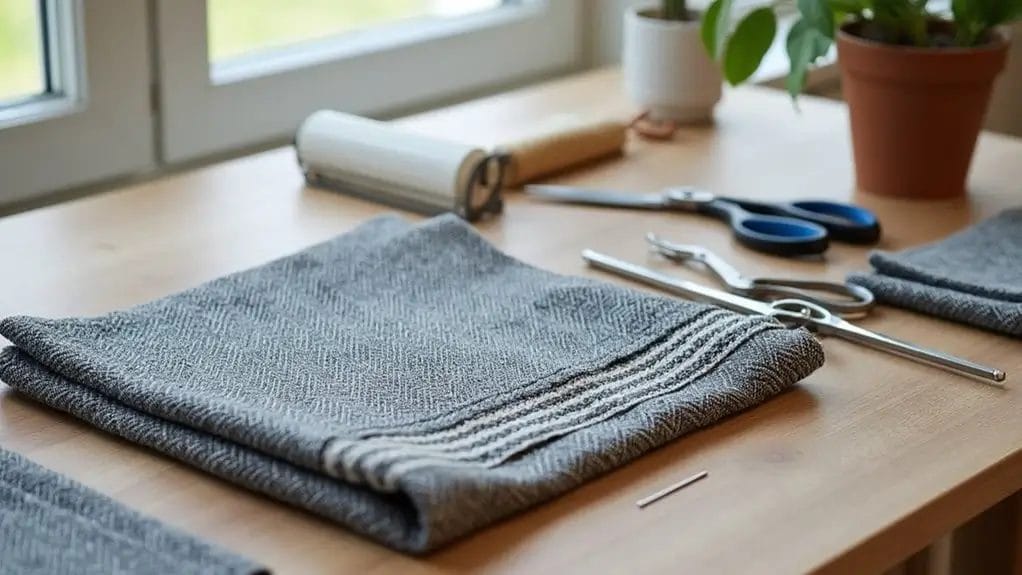
When selecting a pattern for tweed, you'll want to choose designs with minimal seams and simple lines to showcase the fabric's distinctive weave and texture.
You'll need to match your tweed with an appropriate lining fabric, such as silk charmeuse or rayon bemberg, to guarantee smooth wear and reduce friction against undergarments.
For structural support, opt for a medium to heavyweight fusible interfacing that won't overwhelm your tweed but will maintain the garment's shape through regular wear.
Selecting the Right Pattern for Tweed
How do you choose the perfect pattern for your tweed project? Start by matching the pattern's recommended fabric weight to your tweed's characteristics. Classic garment designs work exceptionally well with this traditional fabric.
- Structured outerwear patterns like blazers and coats complement tweed's body.
- Simple, tailored silhouettes showcase the fabric's natural texture.
- Patterns with minimal seams reduce bulk at intersection points.
- A-line skirts and straight-cut trousers maximize tweed's drape.
Consider patterns designed specifically for medium to heavyweight wools.
Your chosen pattern should feature clean lines and classic styling elements that harmonize with tweed's robust texture and heritage appeal.
Choosing the Appropriate Lining and Interfacing
The right pattern selection leads naturally to preparing your tweed project's foundational elements - lining and interfacing.
Choose a smooth, lightweight lining fabric like silk charmeuse or rayon to offset tweed's bulky texture. You'll need to stabilize seams and edges with appropriate interfacing weight - opt for medium-weight fusible for structured areas and lightweight for less rigid sections.
Consider your tweed's weave density when selecting interfacing. Looser weaves require more stabilization, while tighter ones need less support.
Test your interfacing on fabric scraps first to verify it doesn't alter the tweed's drape or create unwanted stiffness in your finished garment.
Cutting Tweed Fabric
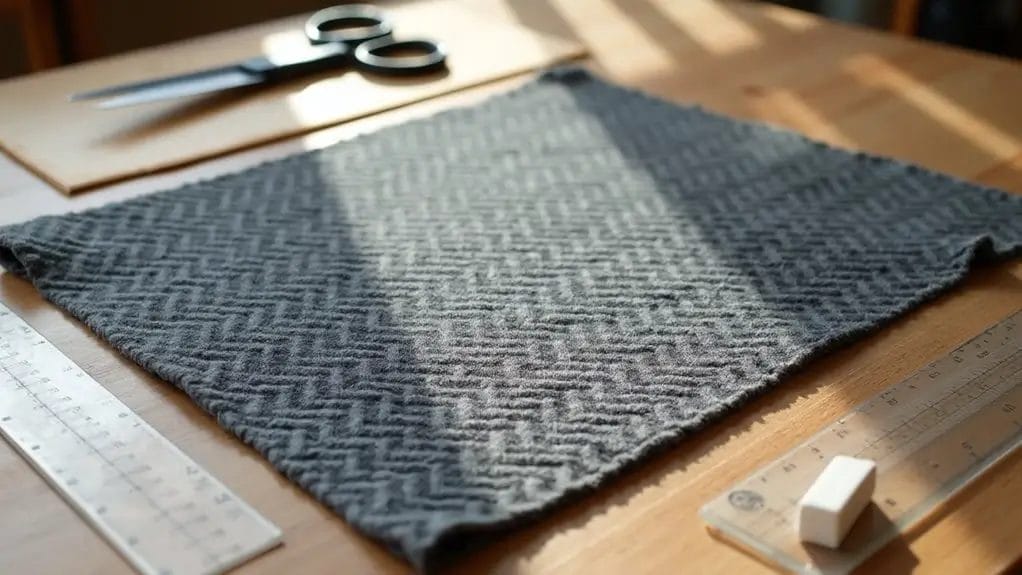
When cutting tweed fabric, you'll need sharp fabric shears, a rotary cutter with self-healing mat, pattern weights, and marking tools specifically designed for textured materials.
You'll achieve cleaner cuts by laying your tweed flat on a large, smooth surface and aligning the pattern pieces with the fabric's distinctive diagonal weave.
Working with a single layer and using pattern weights instead of pins will help prevent the tweed from shifting while you cut.
Tools You’ll Need for Cutting
Proper cutting tools make all the difference when working with tweed's dense, textured weave. You'll need specialized equipment to prevent fraying and guarantee clean, precise cuts through this substantial fabric.
Essential cutting tools for tweed include:
- Sharp fabric shears with at least 8-inch blades
- Rotary cutter with a fresh, sharp blade
- Self-healing cutting mat with grid lines
- Pattern weights or heavy pins to prevent shifting
Always cut tweed in a single layer when possible, and confirm your tools are razor-sharp. Dull blades can snag or distort the weave, leading to uneven edges that'll affect your final garment's quality.
Tips for Accurate Cutting of Tweed
Armed with sharp cutting tools, you'll need to follow specific cutting techniques to master tweed's challenging texture. Always cut in a single layer with the fabric face up, following the weave's direction to prevent distortion.
Secure your tweed fabric firmly with pattern weights rather than pins to avoid shifting. Be careful when handling tweed's loose edges - they can unravel quickly.
Consider marking your cutting lines with tailor's chalk, then cut slowly and deliberately along these marks. Leave generous seam allowances of at least 5/8 inch to accommodate tweed's tendency to fray and allow room for clean finishes.
Step-by-Step Guide to Sewing with Tweed
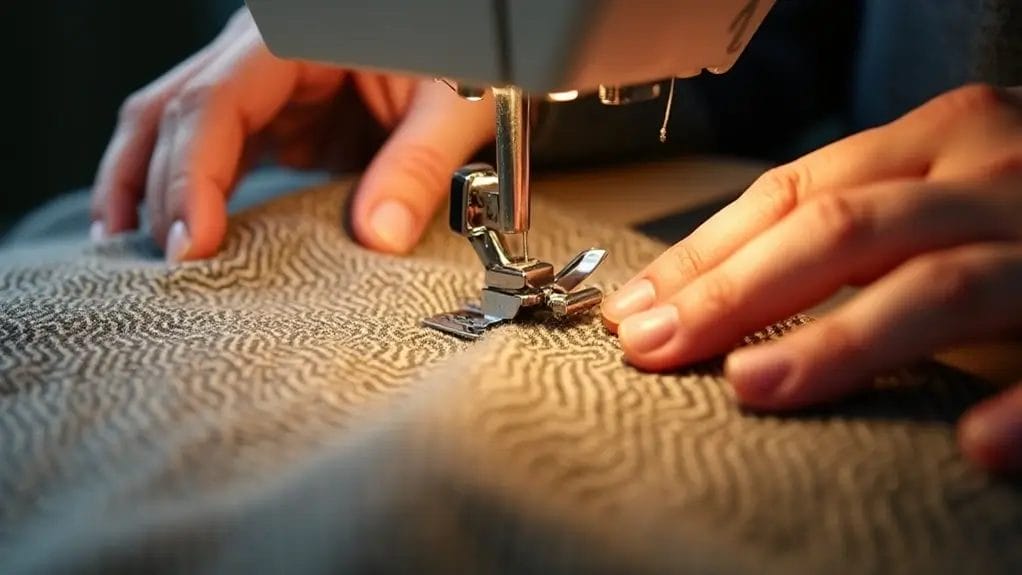
When you're ready to sew tweed fabric, you'll need to adjust your machine's settings with a longer stitch length and lower tension to accommodate the fabric's thick, loose weave.
You'll find that careful pinning and basting are essential steps to prevent the tweed's layers from shifting during construction, especially at seam intersections and curved areas.
Working systematically through your seams and properly finishing the edges with either binding or serging will give your tweed garment a polished, professional appearance.
Preparing Your Sewing Machine
Before starting your tweed project, you'll need to adjust your sewing machine to handle this thick, textured fabric.
Select a size 90/14 or 100/16 needle to accommodate the bulk, and choose strong polyester thread that can withstand the fabric's texture.
- Install a walking foot to prevent layers from shifting
- Increase your stitch length to 3.0-3.5mm
- Loosen your upper thread tension slightly
- Switch to a straight stitch plate for clean seams
Test your settings on a tweed scrap before proceeding with your project.
You'll know your machine is properly calibrated when the stitches are even and the fabric feeds smoothly without puckering.
Pinning and Basting
Proper pinning and basting techniques are essential for working with tweed's loose weave and tendency to shift.
Pin perpendicular to your seam lines every 2-3 inches, using fine silk pins to prevent damage to the loosely woven fibers. When basting, use a long running stitch with lightweight thread that won't mar the fabric.
For curved seams or complex pattern pieces, double-baste to secure layers firmly.
Work from the center outward, catching all fabric layers evenly. Remove your basting stitches carefully after you sew the final seam to avoid snagging or distorting the tweed's texture.
Sewing Seams
Essential sewing techniques for tweed require specific machine settings and careful handling. When sewing seams, use a longer stitch length of 2.5-3.0mm to prevent fabric distortion.
Press seams open immediately after stitching to create crisp edges.
For professional results with tweed fabric:
- Test stitch tension on scraps before sewing main pieces
- Grade seam allowances to reduce bulk at intersections
- Press seams with a pressing cloth to prevent shine
- Use a walking foot to prevent layers from shifting
Consider the fabric's nap and pattern matching while joining pieces. Handle intersecting seams with extra care, trimming corners to minimize bulk.
Finishing Edges
Finishing edges in tweed fabric demands specialized techniques due to the material's loose weave and tendency to fray. To protect raw edges, you'll need to apply a bias binding.
Cut your binding strips at a 45-degree angle and press them in half lengthwise before attaching.
For a professional edge finish, stitch the binding to your tweed's right side, fold it over to the wrong side, and topstitch carefully. You can also serge the edges first, then apply the binding for extra stability.
Remember to test your chosen finish on a scrap piece before working on your garment.
Adding Lining and Interfacing
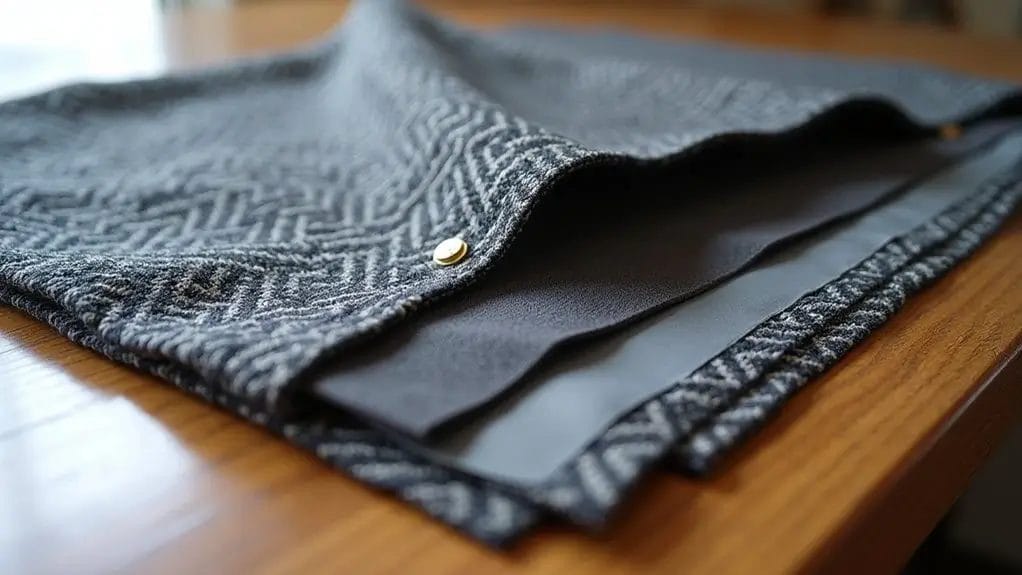
When working with tweed garments, you'll need to properly interface key areas like collars, cuffs, and facings to maintain the fabric's structure and prevent stretching.
You can attach interfacing by fusing it to your tweed pieces before construction, ensuring you test the heat settings on a scrap to avoid damaging the wool fibers.
For a professional finish, you'll want to add a smooth lining fabric that complements your tweed's weight, typically securing it at the seam allowances and hand-tacking at strategic points to allow proper drape and movement.
How to Attach Lining to Tweed
To achieve a polished and professional finish with tweed garments, you'll need to properly attach both lining and interfacing materials.
When sewing with tweed, use couture construction techniques to secure the lining for a jacket or other structured piece.
- Catch-stitch the lining to the tweed along seam allowances, keeping stitches invisible from the right side.
- Hand-sew the hem with a narrow fell stitch, allowing enough ease for movement.
- Secure sleeve linings at the armhole using a floating technique.
- Tack lining at strategic points like princess seams and shoulder seams.
Match grain lines between lining and tweed for proper drape and professional results.
Using Interfacing for Structure and Support
Selecting the right interfacing is crucial for maintaining tweed's structural integrity while preventing its characteristic looseness from compromising your garment's shape.
You'll need to choose a medium to heavyweight fusible interfacing that complements tweed's texture without adding excessive bulk.
Apply interfacing to areas traditionally prone to stretching, such as collars, cuffs, and facings. Cut your interfacing slightly smaller than your pattern pieces to prevent edge show-through.
When fusing, use a pressing cloth and work from the center outward to stabilize the fabric effectively. Test your interfacing on a scrap first to confirm proper adhesion and drape.
Final Touches
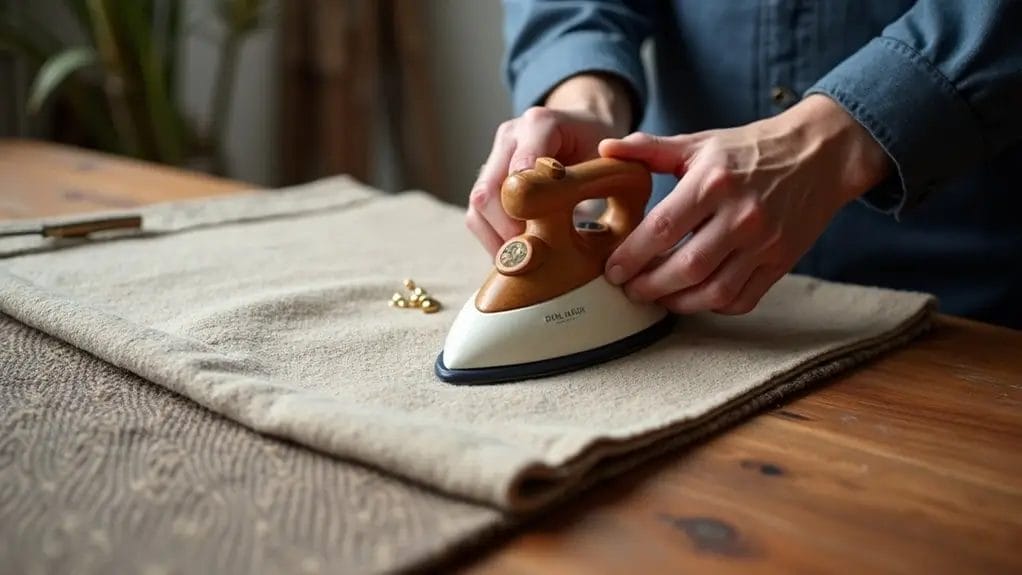
Once you've completed your tweed garment, you'll need to press it carefully using a pressing cloth and steam to set the seams and create crisp edges.
You'll want to maintain your tweed creation by storing it on a padded hanger and brushing it periodically with a soft clothing brush to remove dust and restore the fabric's texture.
When cleaning becomes necessary, opt for dry cleaning to protect the wool fibers and maintain the garment's structure and shape.
Pressing and Finishing Your Tweed Project
When you reach the final stage of your tweed project, proper pressing and finishing techniques become essential for achieving a professional, polished appearance. The woven together fibers require careful attention to preserve the fabric's surface texture while creating crisp edges.
- Press on the wrong side using a pressing cloth to protect the piece.
- Apply seam tape to stabilize edges and prevent fraying.
- Steam press lightly in the direction of the fabric's grain.
- Let each pressed section cool completely before handling.
Remember to test your pressing temperature on a scrap piece first, as different tweed blends respond differently to heat.
Maintain consistent pressure to avoid flattening the fabric's distinctive texture.
Tips for Care and Maintenance of Tweed Garments
Proper care and maintenance of tweed garments will considerably extend their lifespan and preserve their distinctive texture.
Store your wool tweed pieces in a cool, dry place using sturdy hangers to maintain their shape. Brush the thick fabric gently after each wear to remove surface dirt and restore the natural nap.
When cleaning, dry clean only unless the label indicates otherwise. Between cleanings, air out your tweed clothing outdoors; the breathable nature of wool helps eliminate odors.
Avoid touching the fabric with dirty hands, as natural oils can affect the surface. For minor repairs, use matching thread and follow the original weave pattern.
Frequently Asked Questions
Can Tweed Fabric Be Used for Summer Clothing?
You'll find traditional tweed too heavy for summer wear, but you can opt for lightweight cotton-blend tweeds or tropical weight wool tweeds that offer better breathability and seasonal comfort.
What's the Best Thread Tension Setting for Sewing Tweed?
You'll want your upper thread tension between 4-5 for medium-weight tweeds. Test on scraps first, adjusting slightly higher for bulkier weaves and lower for lighter-weight tweed variations.
How Do I Remove Wrinkles From Tweed Without Damaging It?
Steam your tweed from the wrong side using a pressing cloth, keeping the iron slightly elevated. Don't press directly on the fabric's surface, and work in the direction of the nap.
Can Tweed Be Machine Washed Instead of Dry Cleaned?
Don't machine wash your tweed - it'll cause shrinkage, misshapen fibers, and possible felting. You'll need to dry clean it to maintain the fabric's structure, weave integrity, and professional finish.
Is Tweed Suitable for Making Children's Clothing?
You'll find tweed's durability ideal for kids' outerwear and structured pieces, but its scratchy texture and heavyweight nature aren't comfortable for everyday children's clothing. Consider lining garments for comfort.
Conclusion
You'll find that mastering tweed sewing opens up endless possibilities for creating timeless garments. By following proper cutting techniques, using the right machine settings, and incorporating appropriate interfacing, you've laid the groundwork for professional-looking pieces. Don't forget to press your seams thoroughly and add quality linings. Your attention to these technical details will result in a well-crafted tweed garment that'll last for years.


0 comments